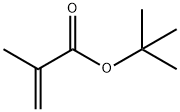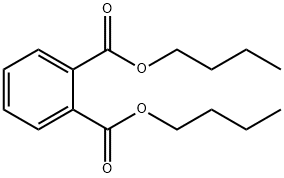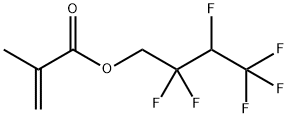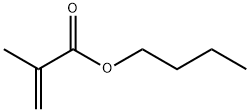tert-Butyl methacrylate
Synonym(s):tert -Butyl α-methacrylate;tert -Butyl methacrylate;1,1-Dimethylethyl methacrylate;Acryester TB
- CAS NO.:585-07-9
- Empirical Formula: C8H14O2
- Molecular Weight: 142.2
- MDL number: MFCD00048245
- EINECS: 209-548-7
- SAFETY DATA SHEET (SDS)
- Update Date: 2024-12-18 14:08:57

What is tert-Butyl methacrylate?
Description
Tert-butyl methacrylate (TBMA) is an ester of Methacrylic acid used as a raw material component in synthesising polymers. TBMA is a functional monomer consisting of a methacrylate group with a characteristic high reactivity and a cyclic hydrophobic group. Copolymers of tert-Butyl Methacrylate (TBMA) can be prepared with (meth)acrylic acid and its salts, amides, and esters, as well as with (meth)acrylates, acrylonitrile, maleic acid esters, vinyl acetate, vinyl chloride, vinylidene chloride, styrene, butadiene, unsaturated polyesters and drying oils, etc. It can be used in emulsion polymerization similar to other well-known acrylates like Butyl Methacrylate or Methylmethacrylate. It is a very useful feedstock for chemical syntheses because it readily undergoes addition reactions with a wide variety of organic and inorganic compounds. It imparts chemical resistance, adhesion, hydrophobicity, hardness, scratch resistance, heat resistance, high solids, and weatherability to polymers.
Chemical properties
Colorless liquid
The Uses of tert-Butyl methacrylate
tert-Butyl methacrylate (tert-BMA) can be used in the formation of homo and block copolymers by atom transfer radical polymerization (ATRP) for potential usage in coatings, biomaterials and flocculants.
General Description
A colorless liquid with an ester like odor. Flash point below 141°F. Less dense than water and insoluble in water.
Air & Water Reactions
Highly flammable. Insoluble in water.
Reactivity Profile
TERT-BUTYL METHACRYLATE is an ester. Esters react with acids to liberate heat along with alcohols and acids. Strong oxidizing acids may cause a vigorous reaction that is sufficiently exothermic to ignite the reaction products. Heat is also generated by the interaction of esters with caustic solutions. Flammable hydrogen is generated by mixing esters with alkali metals and hydrides.
Health Hazard
Inhalation or contact with material may irritate or burn skin and eyes. Fire may produce irritating, corrosive and/or toxic gases. Vapors may cause dizziness or suffocation. Runoff from fire control or dilution water may cause pollution.
Flammability and Explosibility
Flammable
Purification Methods
Purify as for butyl acrylate. [Beilstein 2 IV 1582.]
Properties of tert-Butyl methacrylate
| Melting point: | -60°C |
| Boiling point: | 132 °C (lit.) |
| Density | 0.875 g/mL at 25 °C (lit.) |
| vapor pressure | 7.13hPa at 25℃ |
| refractive index | n20/D 1.415(lit.) |
| Flash point: | 81°F |
| storage temp. | 2-8°C |
| solubility | Insoluble in water |
| form | clear liquid |
| color | Colorless |
| Water Solubility | 464mg/L at 20℃ |
| InChI | InChI=1S/C8H14O2/c1-6(2)7(9)10-8(3,4)5/h1H2,2-5H3 |
| CAS DataBase Reference | 585-07-9(CAS DataBase Reference) |
| EPA Substance Registry System | tert-Butyl methacrylate (585-07-9) |
Safety information for tert-Butyl methacrylate
| Signal word | Warning |
| Pictogram(s) |
 Flame Flammables GHS02  Exclamation Mark Irritant GHS07 |
| GHS Hazard Statements |
H226:Flammable liquids H315:Skin corrosion/irritation H335:Specific target organ toxicity, single exposure;Respiratory tract irritation |
| Precautionary Statement Codes |
P210:Keep away from heat/sparks/open flames/hot surfaces. — No smoking. P233:Keep container tightly closed. P240:Ground/bond container and receiving equipment. P241:Use explosion-proof electrical/ventilating/lighting/…/equipment. P242:Use only non-sparking tools. P303+P361+P353:IF ON SKIN (or hair): Remove/Take off Immediately all contaminated clothing. Rinse SKIN with water/shower. |
Computed Descriptors for tert-Butyl methacrylate
| InChIKey | SJMYWORNLPSJQO-UHFFFAOYSA-N |
| SMILES | C(OC(C)(C)C)(=O)C(C)=C |
New Products
Tert-butyl bis(2-chloroethyl)carbamate (S)-3-Aminobutanenitrile hydrochloride N-Boc-D-alaninol N-BOC-D/L-ALANINOL N-octanoyl benzotriazole 4-Hydrazinobenzoic acid 3,4-Dibenzyloxybenzaldehyde 1,1’-CARBONYLDIIMIDAZOLE R-2-BENZYLOXY PROPIONIC ACID 1,1’-CARBONYLDI (1,2-4 TRIAZOLE) 4-HYDROXY BENZYL ALCOHOL 3-NITRO-2-METHYL ANILINE (2-Hydroxyphenyl)acetonitrile 4-Bromopyrazole 5-BROMO-2CYANO PYRIDINE 5,6-Dimethoxyindanone 5-broMo-2-chloro-N-cyclopentylpyriMidin-4-aMine 4-methoxy-3,5-dinitropyridine 2-(Cyanocyclohexyl)acetic acid 2-aminopropyl benzoate hydrochloride 1-(4-(aminomethyl)benzyl)urea hydrochloride tert-butyl 4- (ureidomethyl)benzylcarbamate diethyl 2-(2-((tertbutoxycarbonyl)amino) ethyl)malonate Ethyl-2-chloro((4-methoxyphenyl)hydrazono)acetateRelated products of tetrahydrofuran








You may like
-
 tert-Butyl Methacrylate Monomer (stabilized with MEHQ) CAS 585-07-9View Details
tert-Butyl Methacrylate Monomer (stabilized with MEHQ) CAS 585-07-9View Details
585-07-9 -
 tert-Butyl methacrylate CAS 585-07-9View Details
tert-Butyl methacrylate CAS 585-07-9View Details
585-07-9 -
 55441-95-7 99%View Details
55441-95-7 99%View Details
55441-95-7 -
 N-Vinylformamide 99%View Details
N-Vinylformamide 99%View Details
13162-05-5 -
 Chloro Uracil 1820-81-1 99%View Details
Chloro Uracil 1820-81-1 99%View Details
1820-81-1 -
 2-ethyl-6-methyl-3-hydroxypyridine succinate 99%View Details
2-ethyl-6-methyl-3-hydroxypyridine succinate 99%View Details
127464-43-1 -
 2-ETHYLPYRIDINE 100-71-0 99%View Details
2-ETHYLPYRIDINE 100-71-0 99%View Details
100-71-0 -
 181228-33-1 (S)-Methyl 3-amino-2-((tert-butoxycarbonyl)amino)propanote Hydrochloride (DAP-OMe. HCl) 99%View Details
181228-33-1 (S)-Methyl 3-amino-2-((tert-butoxycarbonyl)amino)propanote Hydrochloride (DAP-OMe. HCl) 99%View Details
181228-33-1